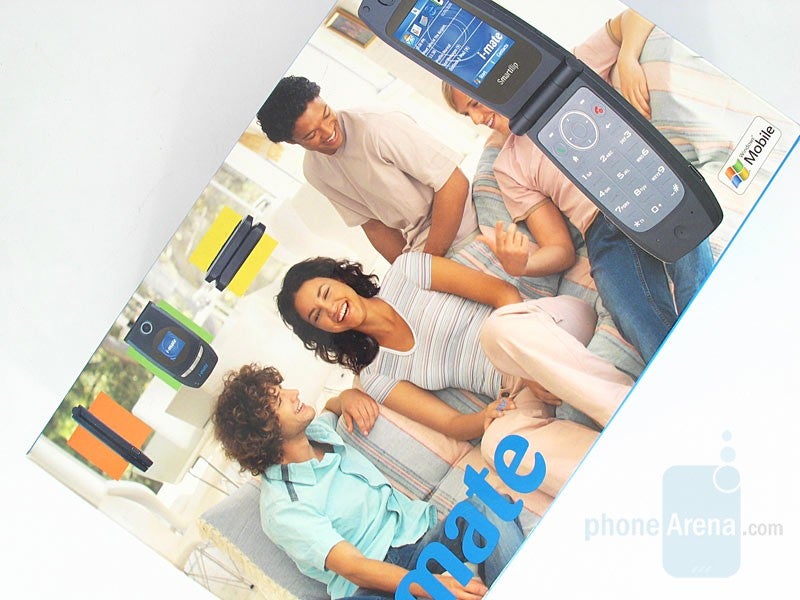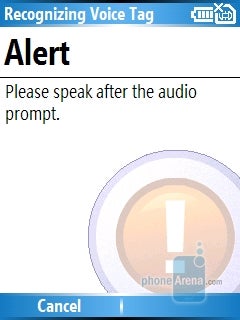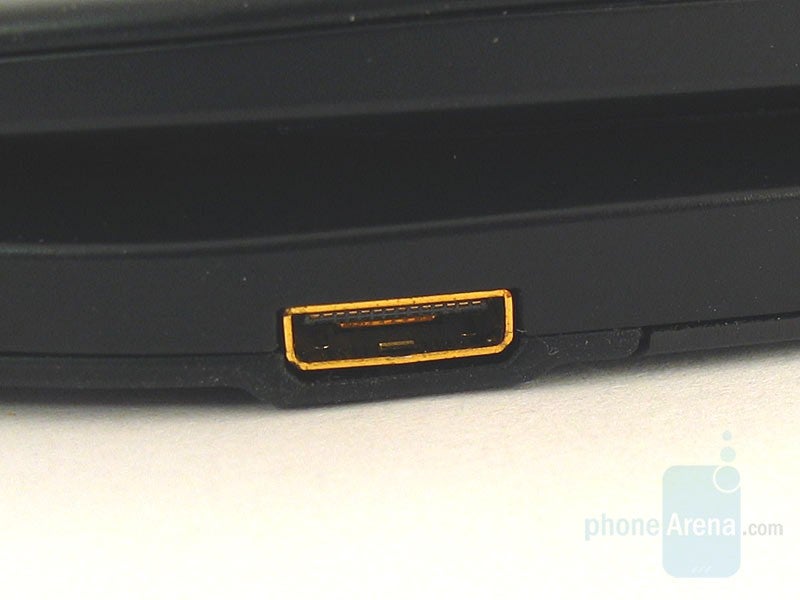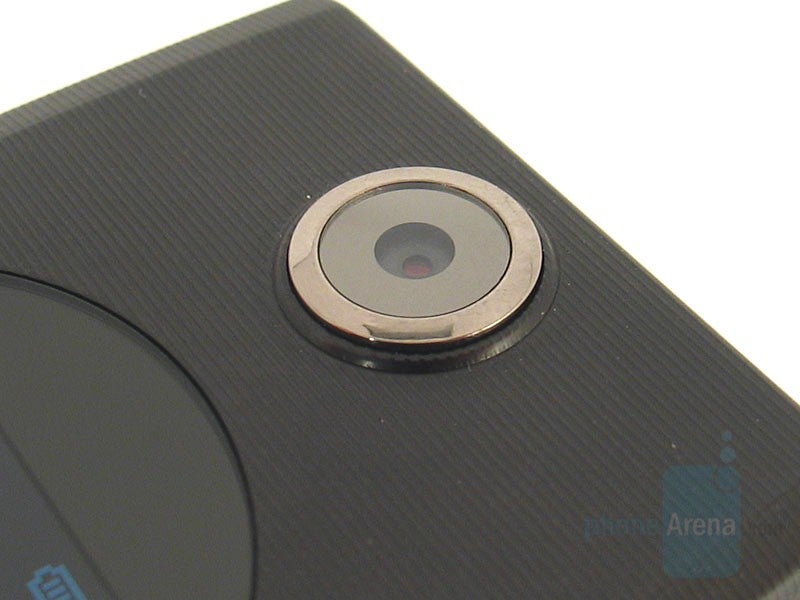i-mate Smartflip Review

The set of Smartflip contains all the necessary tools for its adequate usage: charger,
computer connecting cable, leather case and stereo headphones for listening to music.

Unfortunately, instead of the standard mini-USB and 2.5 mm stereo jack, one combined NTS port has been used to connect all the accessories; thus, in case you lose or damage your cable, you will need to look for one for this specific model and will not be able to use something standard, compatible with a lot of telephones and other appliances. This is a novelty for the NTS and we suppose it has been made indispensable with regard to the phone’s slim profile.
Smartflip is a comparatively big clamshell phone with an in-built antenna. Its colour is black and its form has an austere look with the lower part slightly beveled and narrower but not with a rounded edges either. Most of the front and rear panels are made of metal, which adds to the austere hi-end feeling inspired by its design and by its feel. The phone is exceptionally stable and you will not be disappointed in any way by its fine workmanship. It can be opened or closed with one hand but since it has no special automated mechanism we prefer to do so by both hands; naturally it has a spring to help with the opening, which does that quite well – after the lid has been half-opened it is ‘caught’ and opened to the end.
Being a lid-phone, Smartflip has two displays instead of one: in a circular opening on the front lid there is a small (1.2”, 128 x 128 pix) 65 thousand colour one. Its main use is for system information, helping you avoid opening the phone for trifles such as battery level, signal strength, time, etc. Normally it also visualizes caller identities and informs you about missed calls or received messages. However, apart from these standard applications the colour display may be used for multimedia – with its help you can take a picture of yourself with the camera or pick the music to listen to using the small interface of a media player. In our view it is very convenient and we like it but unfortunately the display is hard to see by bright daylight, which can render it unusable. Moreover, the circular glass surrounding it gets easily stained, turning into a mirror.
Inside there is a bigger 2.2-inch display with a much higher resolution (QVGA 240 x 320 pix) and better quality. This is the main display of the phone and in most cases – the one to supply the information. The screen itself has a sufficient resolution for its size, the brightness is normal and the colors are deep and real - the images there look really good.
Apart from the standard touch-buttons when opened, Smartflip has four side ones and three on the front panel: on the left there is a volume control and a shortcut to the voice commands and on the right there is a shortcut to the camera, also used as a shutter key. These buttons are situated on the upper shell and we consider them inconvenient, only the one for the camera being accessible with relative ease. This, however, is valid for the closed phone; when opened, we were hardly able to push any of the buttons. In addition to the side ones, there are three control buttons for the music player: play/pause and two for changing tracks, but the latter cannot be used as ‘fast forward’ or ‘rewind’. They are easy to push but have almost no relief and therefore are difficult to find. Unfortunately all seven buttons have no back-lighting, which makes their use even more difficult in a dark environment.
The opened keyboard is very different: though almost entirely flat like the one of RAZR, its surface is made of plastic, not metal; the digit buttons are very big and the remaining software buttons, though small, are very convenient, so confusing them is a rarity. We had problems solely with the d-pad which directions (up and down) are shorter than we would like them to be. The entire keyboard is flat and it is hard to say which button is being pushed without looking, the buttons themselves are too close to each other, and the backlighting is light blue-green. It is controlled by a sensor, which helps prolong battery life. Unfortunately it does not control the brightness of the screen as in Blackberry Pearl.
Smartflip is a standard Windows Mobile 5 Smartphone and the software review as a whole will not be a review of the phone, but rather of the operating system used in many different models.
The operating system is generally similar to that for pocket PC telephones and to the computer desktop version but at the same time it is considerably different. For all that, it will be easier for people who are more experienced with such appliances to navigate in it.
The home-screen can be personalized in several ways, but we will consider the one called ‘Windows default’: in standby it is active and contains links to various applications; after the system information there is a bar with large icons representing links (unfortunately even after holding the cursor upon them no information appears as to what they link to) and under them - hour/alarm, upcoming appointments from the calendar, profile and availability of new messages are visualized.
The ‘main’ menu is visualized as a grid of nine icons (with shortcuts from the keyboard), which change their appearance when pointed at. Unfortunately they look rather ‘square’, somehow plain and not eye- catching. Since the menu contains more than 9 icons instead of scrolling you will have to go to the next page by using the ‘more’ option. You can get back by pushing the keyboard ‘back’ button. Submenus are visualized as lists and have digital shortcuts as well.
Applying various color schemes can somewhat personalize the appearance of your menus.
As a whole the navigation is logical and one can easily orientate oneself. The telephone processor does a good job and navigation in the menu is fast, without tedious delays.
As a whole the phonebook is well structured but we can make some critical remarks about it as well: its capacity depends solely on the available memory, which means that in practice you can save an unlimited number of contacts. For each there are numerous fields to be filled, including several phone numbers and e-mails, as well as personal photos and melodies to be shown and played at the time of a call. All the contacts are visualized as a list with an indication on the right as to the type of the number (m – mobile, w – work, etc.).
Looking a contact up can be initiated from two locations (the contact list and the home screen) and in two ways – typing digits for NUMBER or typing letters by pressing each button once (a predictive text input system is activated). Looking up contacts from the contact list is rather unenjoyable: your exact input is not displayed until you arrive at a case of no concurrence, which does not quite make any sense – if you thought you made a mistake when typing, there is no way to make sure you did, so you must delete everything and start anew.
From the home screen the entered digits are displayed. The concurrences (regardless as to number or name) are visualized below and the exact concurrencies are highlighted. As opposed to Blackberry Pearl if the concurrence is of a word, the text you are typing in will remain in the form of digits and will not change. As a whole looking up from here is convenient, fast, trouble-free and leads to good results.
The organizer under Windows is relatively well set. Its design is intended to be readily compatible with the Outlook on your computer, therefore there is a full functionality. A few clicks are enough to add notes to the calendar for a certain day (one can add reminders, too) and those that are near in time will be visualized on your home screen.
There is not much difference when working with tasks either – you can easily add a new one or assign a ‘completed’ status to an old one. Though it may seem a bit strange to us, there is no option in the organizer to simply add ‘notes’, which is a part of the computer ‘outlook’ and of the ‘elder brother’ – WM for Pocket PCs.
The calculator is in the ‘Accessories’ folder and inexplicably has no graphic interface whatsoever. It is usable, but inconvenient and unenjoyable to work with. There are neither more complicated ‘scientific’ options nor a converter of measurements.
You can add only one alarm and at that you will need to go through quite a number of menus – settings – clock & alarms – alarms – and unfortunately there is no setting there for the sound, but for the time only. We consider this to be quite inconvenient and while we were using the phone we were not able to make a single successful attempt to set the right sound for the alarm, so that it would make a distinct sound (this can be done only through ‘profiles’).

Messaging:
The messageinterface does not seem to be very convenient, at least as far as we are concerned.The standard text, multimedia and e-mails are all in one and the same menu. Towrite a new one is in fact easy, but you get to know that there are readytemplates (only for MMS) only when you start writing a new one and open ‘Menu”.You must use the same menu in case you do not want to send a message you havealready started writing – otherwise the standard navigation with the ‘back’arrow and the red receiver will not do – the message will not be closed, butjust minimized (by the receiver button) at best. For instance, there will be noindexation if there are no messages in the inbox – you will simply see a blankscreen.
With the settingsof the e-mail account you can limit the download of messages to: Just today / 3days / 5 / 7 / 30 / All days. Another restriction you can impose is: Headersonly / First 500 bytes / 1000 bytes / 5000 bytes/ Entire message.
Connectivity:

For localconnection it supports Bluetooth version 1.2 and a lot of profiles, includingthe wireless multimedia A2DP for stereo sound. You can also connect it to acomputer by a USB cable plugged in the right-side port of the telephone. Youwill need an installed Microsoft Active Sync on your PC in order to achieve aneasy synchronization of the phone with Microsoft Outlook at your will.
Thetelephone has the standard Windows Mobile Internet Explorer adapted tosmartphones. It is a good browser and capable of opening Internet pages the wayyou are accustomed to watching them on a computer. We used the ‘full screen’regime to make use of the whole screen area – simple pages as Google are easilyloaded but if you choose to open something heavier as PhoneArena.com forexample, you will need to wait, because you rely on EDGE. Unfortunately this page turned out to be too heavy for the slowconnection and it was impossible to load all the photos.

Camera:
Smartfliphas a 1.3 mega pixel camera which, unfortunately, does not have any specializedcapabilities such as automatic focus or a flashlight and as a whole is not on apar compared to the phones presently on the market. It is situated at the topof the front lid and is slightly bulging.It starts comparatively fast (4 –5 sec) after holding the shortcut key on the left side – in spite of thecamera’s interface, which is not particularly elaborate, it is quite easy towork with it. In the respective menu you can choose the white balance andcolour effects as well as execute various settings, including resolution andcompression. It takes the picture about 2 – 3 sec after pushing the button eventhough there is no automatic focus and you need one more second to get readyfor the next picture – thus the interval between two pictures is approximately4 seconds.
The cameraphotos are hardly of any worth – they have a very weak detail(a lot of artefacts and blurring) and unrealcold colours, but a strong contrast. Indoors, even with strong lighting, thereis more ‘noise’ (the latter being present in the outdoor photos as well). Withthe light going down it increases at the expense of quality, poor as it is.
Multimedia:
For playingmusic and going through video files the telephone has a built-in Windows MediaPlayer: it is very similar to the one for PPC devices) and in it you can lookat the songs’ performer / album/ genre provided that this information isavailable in the ID3 song tags. During playback small buttons (back, pause,forward) are visualized on the whole screen and the file name and its qualitycan be viewed at the top. Fortunately, here you can use fast forward and rewindfunctions in contrast to the buttons of the external screen. This is achievedby holding one of the directions of the d-pad.
Theloudspeaker sound has medium volume and in fact sounds well for a miniaturephone speaker. However you will need headphones for a more realistic musicalexperience; the ones from the set of our smartphone had a decently pleasantsound compared to other mobile-set headphones. They are strong enough andlistening to music with them is not quite bad, but they lack dynamics, fidelityand reality, and a discerning listener would not favour the low-frequencyreproduction. If you belong to that group of listeners you will definitely needto replace them with some expensive brand, but unfortunately it will be hard tofind the necessary adapter between the phone’s unique port and the standard 3.5mm jack, so that to use your Hi-Fi headphones. However the Bluetooth is readilyavailable for connecting to wireless ones.
As far asviewing video files is concerned, there is a full utilization of the screenarea and the additional option to look through the file in full-screen mode.
Software:
Thetelephone features a 64 MB built-in memory and the same amount of RAM. The availablememory can be increased by usingmicroSD cards but unfortunately the slot for them is situated under the battery coverand the SIM-card – there is no way to replace the card without switching thephone off since it automatically turns off after removing the battery cover.
Our versionof the telephone arrived with pre-installed programmes of the office pack ClearVue – here one can find previewers for Microsoft Office documents (Word, Excel,PowerPoint) and PDF files. As a whole, the software works well butunfortunately is solely capable of viewing, not editing files. Problems arosewhen we tried to open a bigger Excel document with considerable amount ofinformation and images – the telephone crashed and the document could not beviewed. What is more, when we tried to open a big (1.2 Mb) PDF file there wasan error message stating that the document cannot be opened.
Thetelephone is supplied with two games, standard for Windows Mobile –Solitaireand Bubble Breaker. Additional games and software can easily be added.
Performance:
Despite thecomparatively weak processor Texas Instruments OMAP 850, running at 195 MHz,Smartflip’s work is remarkably stable and fast and remains so even with anumber of loaded applications in the RAM.
We were exceptionallypleased by its performance as a telephone – it has quite a strong signal inspite of the built-in antenna and it did quite well and exceeded the norm.Though it did not achieve the level of the leading phones like BlackberryPearl, it still can be considered very reliable in areas with weak signal.
Duringconversation it is also up-to-standard – the other side can hear you very well,with sufficient sound volume and clearly, without any noise at that. The soundof the voice is realistic and with a rich key. You hear a bit more lowfrequency than in reality, but it is clear and distinct – sound volume is aboveaverage which makes the phone perfectly usable even in very noisy environments.
Conclusion:
Smartflipis definitely a telephone that does not disappoint its users: it has a good designand a solid surface, which is pleasant to touch, revealing its high class.Apart from being a multi-functional device (thanks to its operating system), ithas a very good performance as a phone – it works fast, strong signalreception, and the sound quality is high – the phone easily copes with its mainobligation.









Things that are NOT allowed: